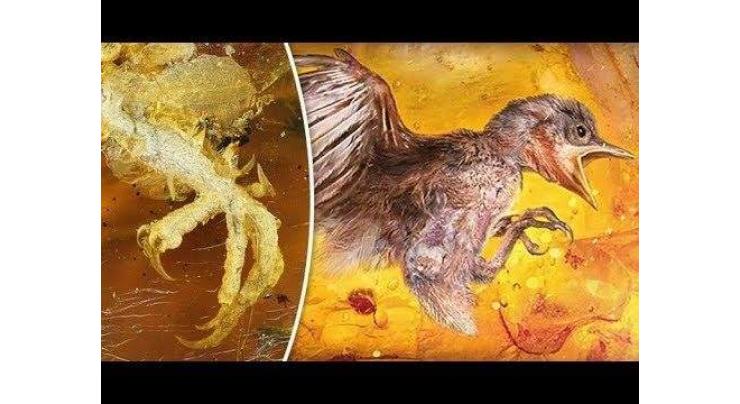
Prehistoric "pancake Bird" Sheds Light On Ancient Avians
Faizan Hashmi Published February 02, 2018 | 03:19 PM

The remains of a prehistoric bird dating back some 100 million years was discovered inside a piece of Burmese amber
BEIJING,(APP - UrduPoint / Pakistan Point News - 02nd Feb, 2018 ) :The remains of a prehistoric bird dating back some 100 million years was discovered inside a piece of Burmese amber. The finding was announced Friday in Beijing by paleontologists from China, Canada and the United States.
Similar to the smallest modern bird -- the bee hummingbird -- in size, the 5-cm bird is well preserved in the piece of amber. The remains, dating from the late Cretaceous period, feature "skeletal material and soft tissues in unmatched detail," according to an academic paper published as the cover article of the journal Chinese Science Bulletin.
Professor Tseng Kuowei at the University of Taipei noted that the specimen provides a unique perspective for research as it is split along the coronal plane, exposing much of its internal anatomy and giving it the nickname "pancake bird." Although parts of the skull and most of the right wing and leg are missing, it is still the most complete prehistoric bird specimen found in Burmese amber so far, according to Jingmai O'Connor, a researcher at the Institute of Vertebrate Paleontology and Paleoanthropology in China.
Based on the latest study, the bird's skeletal structure and plumage patterns are basically in alignment with those of the enantiornithes.
Enantiornithes first appeared in the Cretaceous period and died out at the same time as their non-avialan dinosaur relatives.
The extinct avialans were one of the most crucial branches in the evolution of ancient birds. "The density and length of the feathers preserved along the exposed neck and head regions may suggest that this specimen is older than hatchling or juvenile remains discovered in the area," said Xing Lida, associate professor at China University of Geosciences.
"So far, this pancake bird is the most physically developed ancient bird ever discovered in amber," Xing said. Moreover, structures found in its Primary feathers indicated the rigid feathers were capable of flight, making them more consistent with feathers from advanced flying birds than typical enantiornithes.
It is not clear whether the bird was alive when it was sealed in resin. The missing internal organs and lack of soft tissue around the femur suggest it might have died before it was trapped in the amber.
Paleontologists believe that further studies of the specimen will shed light on the process of corpse preservation as well as the diversity and geographical distribution of ancient birds.
Related Topics
Recent Stories

Robinson, bowlers help New Zealand go 2-1 up against Pakistan

Shahzeb Chachar to hold khuli kachehri on April 26

Heatwave amid Israel's aggression in Gaza brings new misery, disease risk

Tourism must change, mayor says as Venice launches entry fee

Court adjourns Judicial Complex attack case till May 17

Nasreen Noori’s book ‘Popatan Jahra Khwab’ launched

Wafaqi Mohtasib inspection team visits Excise and taxation office

AJLAC announces 5th Conference titled ‘People’s Mandate: Safeguarding Civil ..

Pak-US officials engage to enhance trade, investment ties

IBCC to promote educational excellence, expand regional presence

Pakistani 'Blue Helmets' serving UN Peacekeeping Mission in DR Congo set to leav ..

Putin says plans to visit China in May
More Stories From World
-
Slot 'confident' of Liverpool job as 'negotiations' take place
3 hours ago -
Google parent Alphabet's Q1 profits beat estimates: company
3 hours ago -
WADA asks 'independent prosecutor' to examine Chinese swimmers case
4 hours ago -
New York court overturns Harvey Weinstein sex crime conviction
4 hours ago -
Bagnaia and Spanish rivals chase victory at Jerez
5 hours ago -
Russian, Ukrainian strikes kill at least 10 in frontline regions
5 hours ago
-

Heatwave amid Israel's aggression in Gaza brings new misery, disease risk
6 hours ago -

Tourism must change, mayor says as Venice launches entry fee
6 hours ago -

Pakistani 'Blue Helmets' serving UN Peacekeeping Mission in DR Congo set to leave after 20 years of ..
6 hours ago -

Putin says plans to visit China in May
6 hours ago -

US reinstates open internet rules rescinded under Trump
6 hours ago -

Honda announces US$11 bn EV battery and vehicle plant in Canada
7 hours ago





